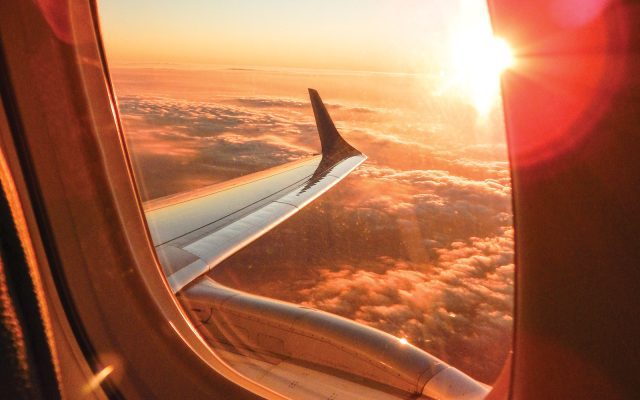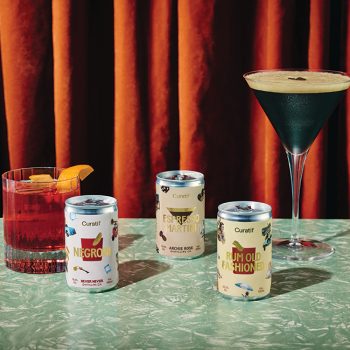Which cocktails are best for air travel?
How does flying affect our senses, and how can brands and consumers be mindful of these effects when choosing beverages at altitude? David T Smith offers some insight.

*This feature was originally published in the December 2023 issue of The Spirits Business magazine.
Air travel can sometimes be hectic, what with delays and security queues, but hopefully once you’re cruising at 35,000 feet there’s an opportunity to take a moment and enjoy a relaxing drink – even if it’s one you’ve had to pay for.
Sadly, bespoke cocktails are a thing of the past on all but very few first-class flights, so what are the secrets of improving your drink experience if they’re not available?
An important disclaimer to make here is that different airlines and countries have various attitudes to passengers bringing on and serving their own alcohol. For example, on all US carriers, passengers are forbidden from serving their own alcohol as per the Federal Register: “§ 121.575 alcoholic beverages: (a) No person may drink any alcoholic beverage aboard an aircraft unless the certificate holder operating the aircraft has served that beverage to him.”
Let’s explore what affects your drinking experience when you’re on a plane, starting with sound. The sounds of the engines, air conditioning, and other equipment creates loud white noise, which researchers at the University of Manchester in the UK have found dull passengers’ sense of sweetness and saltiness.
Taste reduction
Then there’s humidity. At 30,000 feet, a crowded plane can have a relative humidity of around 20% (less on an emptier plane). Such a low humidity causes dehydration, nasal congestion, and increased sinus pressure. It also cuts the general sensitivity of taste and smell by up to 30%, according to a study by Fraunhofer Institute for Building Physics, commissioned by Luthansa.
Airline cabins are pressurised to the equivalent of standing at about 6,000ft to 8,000ft. This dulls the tastebuds, although some destinations of altitude, such as Denver (5,280ft) or Mexico City (7,349ft), will already have a similar air pressure.

The business of flying is driven by date, weight, and fuel, and refreshments are no exceptions to the rule. One airline, Qantas, has a guide that a drink can take no longer than 45 seconds to prepare and must require a maximum of six movements or actions. Given this, pre-made cocktails, whether they be ready-to-drink (RTD) or ready-to-serve (RTS), have an obvious appeal. Australian RTD brand Curatif partnered with Qantas to offer its Tommy’s Margarita (18.5% ABV) in business class flights.
“A Tommy’s Margarita excludes any orange liqueur, and is sweetened with agave nectar. The enhanced savouriness makes it perfect to compensate for the impact of altitude on the passengers’ sense of taste,” says Matt Sanger, managing director of Curatif.
Other examples of RTD success on flights include the Margarita (14.9% ABV) from UK firm Moth, which is available to buy on some British Airways flights. As well as the above, Tip Top Cocktails is available on Delta Airlines, United stock On the Rocks Old Fashioneds, and Southwest and Frontier serve both White Claw Hard Seltzers and Buzzballz (again, Margarita-flavour).
Sweet and savoury
Swiss International Air Lines, meanwhile, serves around 60,000 litres of tomato juice per year, the annual equivalent of one shot glass per passenger, and around 10% of passengers order it.
Tomato juice (or the Bloody Mary) has a light, refreshing combination of sweet and savoury flavours, and is often seasoned with salt or pepper, all of which compensates for a passenger’s dulled sweet and salty flavour receptors. A dulled sense of taste may also help to minimise the more soup-like, vegetal notes that otherwise might deter some drinkers. In flight, tomato juice is also not served from the fridge, as it would typically be stored in a bar or at home, so the texture is less thick and ‘claggy’.
Psychology plays a part, too. For most people, air travel is still a novelty and so, when aboard a plane, they are inclined to be more adventurous, especially if the drinks are free. There is also an association between tomato juice and flying and so a ‘copycat effect’ may also be in play. Finally, air travel can seem draining to a lot of people and so a seemingly healthy and hydrating drink such as tomato juice may seem attractive.
In 2023, London brand The Pickle House launched its Spiced Tomato Mix with pickle juice (winner of a Gold medal from the IWSC) on Virgin Atlantic flights. This mix has the seasoning built in, which helps to reduce the time and number of movements to serve the drink by cabin crew. Importantly, it also helps to maintain consistency.
Top tips
What can consumers do to make the optimal drinking choice in the air? If offered a choice of gin, go for one with a higher ABV, as this will help carry the flavour of the botanicals more. Citrus-forward gins are a good choice, as are the likes of Gordon’s and Tanqueray, which are often found on-board.
Try gin instead of vodka with your tomato juice to make a delicious Red Snapper. Or, liven up a gin and tonic with a fruit teabag of choice. Simply pour the gin into a cup and then infuse the teabag for 30 seconds, before topping up with tonic.
Keeping a few small packets of sugar and pepper with you is an easy way to add some extra flavour your drink.
For an in-the-air Julep, infuse a mint teabag into some whiskey, such as Jack Daniel’s, for 30-60 seconds, add some sugar, and stir.
Bringing an insulated cup or tumbler with you for your drinks will help ice last longer.
It will also save on the use of disposable plastic cups.
Fans of Scotch whisky should note that richer, fruity flavours are often lost in the air, whereas peat and smoke shine through.
For a final zhuzh, why not pack the Bitter Truth’s Cocktail Bitters Traveller’s Set? The bottles are small enough to take on board, most countries consider them food (like a condiment) rather than alcohol, and a dash or two can make a big difference to your drink.
Related news
Top 10 spirits launches in June
